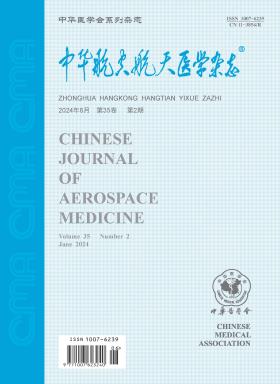Investigation of risk factors of coronary artery stenosis in flying personnel
引用次数: 0
Abstract
Objective To investigate the main risk factors induced to coronary artery stenosis in order to provide evidence for prevention of coronary heart disease in flying personnel. Methods By analyzing the computed tomography angiography (CTA), 44 flying personnel clinically suspected as coronary heart disease were divided into coronary artery stenosis group and normal coronary artery group. The comparisons on age, flying aircraft type, flying duties, body mass index (BMI), flying hours, night flying hours, blood lipid level, serum glucose level, histories of hypertension and smoking were conducted between two groups. The Logistic multivariate regression analysis was used for determining risk factors. Results The CTA results indicated 25 cases (56.82%) of coronary artery stenosis and 19 normal cases. The univariate analysis showed the statistical differences on age, flight hours, night flight hours, and the incidences of hypercholesterolemia, hyper low-density lipoprotein cholesterolemia, Hypo high-density lipoprotein cholesterolemia and hypertriglyceridemia between coronary artery stenosis group and coronary artery normal group (χ2=4.429-14.329, P<0.05). The Logistic multivariate regression analysis showed that hyper low-density lipoprotein cholesterolemia (OR=7.026, 95%CI: 1.831-26.959, P<0.05) and night flight hours (OR=4.461, 95%CI: 1.694-11.746, P<0.05) were the independent risk factors of coronary artery stenosis. Conclusions Hyper low-density lipoprotein cholesterolemia and night flying hours are the independent risk factors of coronary artery stenosis in pilots. These hint that the change of circadian rhythms would be an important factor to induce coronary artery stenosis besides the common risk factors. Key words: Coronary artery stenosis; Circadian rhythm; Risk factors; Flying personnel飞行人员冠状动脉狭窄危险因素调查
目的探讨飞行人员冠状动脉狭窄的主要危险因素,为预防飞行人员冠心病提供依据。方法对44例临床怀疑为冠心病的飞行人员进行ct血管造影(CTA)分析,分为冠状动脉狭窄组和正常冠状动脉组。比较两组患者的年龄、飞行机型、飞行任务、体重指数(BMI)、飞行时数、夜间飞行时数、血脂水平、血糖水平、高血压史、吸烟史。采用Logistic多元回归分析确定危险因素。结果CTA显示冠脉狭窄25例(56.82%),正常19例。单因素分析显示,冠状动脉狭窄组与冠状动脉正常组患者的年龄、飞行时数、夜间飞行时数以及高胆固醇血症、超高低密度脂蛋白胆固醇血症、低高密度脂蛋白胆固醇血症、高甘油三酯血症的发生率差异均有统计学意义(χ2=4.429 ~ 14.329, P<0.05)。Logistic多因素回归分析显示,低密度脂蛋白胆固醇血症(OR=7.026, 95%CI: 1.831 ~ 26.959, P<0.05)和夜间飞行时间(OR=4.461, 95%CI: 1.694 ~ 11.746, P<0.05)是冠状动脉狭窄的独立危险因素。结论低密度脂蛋白胆固醇血症和夜间飞行时间是飞行员冠状动脉狭窄的独立危险因素。提示除了常见的危险因素外,昼夜节律的改变可能是诱发冠状动脉狭窄的重要因素。关键词:冠状动脉狭窄;昼夜节律;风险因素;飞行人员
本文章由计算机程序翻译,如有差异,请以英文原文为准。
求助全文
约1分钟内获得全文
求助全文
来源期刊

中华航空航天医学杂志
航空航天医学
自引率
0.00%
发文量
2962
期刊介绍:
The aim of Chinese Journal of Aerospace Medicine is to combine theory and practice, improve and popularize, actively advocate a hundred flowers bloom and a hundred schools of thought contend, advocate seeking truth from facts, promote the development of the related disciplines of aerospace medicine and human efficiency, and promote the exchange and penetration of aerospace medicine and human efficiency with other biomedical and engineering specialties.
Topics of interest for Chinese Journal of Aerospace Medicine include:
-The content of the journal belongs to the discipline of special medicine and military medicine, with the characteristics of multidisciplinary synthesis and cross-penetration, and mainly reflected in the aerospace industry, aerospace flight safety and efficiency, as well as the synthesis of special medicine, preventive medicine, environmental medicine, psychology, etc.
-Military aeromedicine (Air Force, Navy and Army aeromedicine) and civil aeromedicine, with a balance of aerospace medicine are the strengths of the journal.
-The change in aerospace medicine from a focus on promoting physiological compensatory adaptations to enhancing human performance under extreme environmental conditions is what the journal is helping to promote.
-The expansion of manuscripts in high altitude medicine is also a special emphasis of the journal.
 求助内容:
求助内容: 应助结果提醒方式:
应助结果提醒方式:


